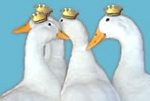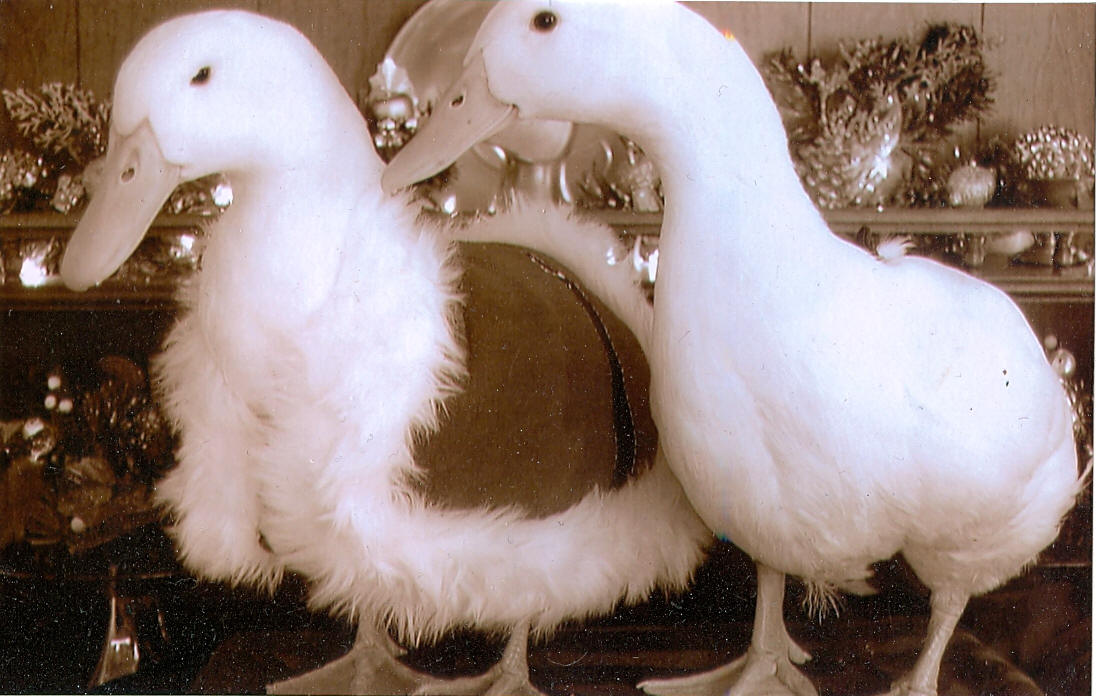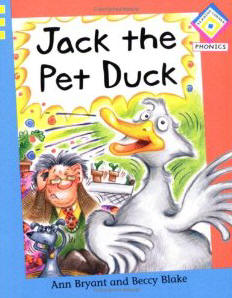Renal Disease
There's nothing worse than having to follow up such a wonderful fundraiser with some sad news... Our sanctuary was hit with a terrible blow when Duran Duran were split a lifetime apart from each other in early March.
Duran "Rio" succumbed to renal disease leaving his 10 year-old brother Duran "Moon" behind to grieve along with us. Through this tremendous and unexpected loss, we have learned a few things that may help save your pet duck or goose. We are going to feature these life-saving articles in our April and May newsletters.
In Rio's case, symptoms did not appear until three weeks before his parting. The first week a decrease in appetite was noted and by the second week he had stopped eating and began drinking incessantly.
Rio's complete symptoms included: diarrhea, increased drinking, severe dehydration, instability (wobbly legs), complete loss of appetite, weight loss, weakness, fluffed up feathers (especially around his neck and face), drooping wings (some days worse than others) and depression.
Rio was rushed to our vet for medical intervention. While we were 90% sure we could rule out parasites, hardware disease and subsequent zinc poisoning, we felt it in his best interests to officially rule each of them out.
Rio had an x-ray, which was clear, but on the odd chance he had already passed a swallowed object, we had our vet go ahead and draw blood for a zinc test and also for a full comprehensive avian blood panel. The zinc test came back negative--as expected. The blood panel revealed that he was anemic, but gave no evidence of any infection.
At the same time a fecal sample was sent off to the lab and parasites were officially ruled out. Another sample was sent off for culturing and it came indicating negative for bacterial infection.
This narrowed down the issue to being either viral in nature or renal. We were hoping for viral. Both conditions call for lots of fluids, so Rio went to the vet twice weekly for IV fluids via a catheter inserted into his leg as well as subcutaneous fluids injected under the skin. If his condition was viral we could syringe feed him his meals and keep him hydrated and hope he would muster through it. As long as he didn't get any worse in the next ten days, he would eventually get overcome it and make a full recovery. If his condition was kidney-related, the fluids and feedings would offer support for the time being.
Because there was a risk of viral infection, Rio was immediately brought home to our basement infirmary and after careful consideration of the risks and benefits, we decided that Moon should be brought in with him. We simply thought what each of them would want and acted on it. Moon proved an effective motivator and rose from his normally subordinate role into one of an alpha leader and caretaker.
Rio was syringe fed a special diet every two hours, 6-7 times a day. Then he was left to rest for the night while a baby monitor kept us linked to his pen.
Although the feedings and hydration helped him grow stronger at first, his strength began to slowly fall off by the second week of his special care. With a viral infection comes either slow improvement or a sudden crash of seizures, fever and/or vomiting--none of this came. Furthermore, Moon (thankfully) did not become ill, nor did any other members of our rescued flock.
At the end of day 14 and with no hope in sight we made the decision to let him go the following morning. His legs and bill had slowly turned from a rosy-red to a yellow hue, a clear indicator of renal failure and by morning he was no longer interested in standing. It was time...
Although Renal Disease can be brought on by bacterial, viral or fungal infections (aspergillus), toxins, medications, heavy metals, vitamin D overload, vitamin A deficiency, urinary tract obstructions or kidney injury/trauma, in Rio’s case renal failure was brought on by kidney tumors that were likely cancerous and unfortunately... untreatable.
"You press the keys and I'll
sing!"Duran Rio (front) and Duran Moon
(rear), August 2010
Tube/Syringe Feeding Dosages
After taking a sick or injured duck or goose without an appetite to your vet for an exam, they may decide some assisted-feeding is in order. Vets will commonly handle tube feedings themselves (especially in the short term) and advise you to administer syringe feedings to your pet.
Duck (average weight 6-7 lbs):
Tube Feeding: 30 mls per each meal, 2-3 times a day.
Syringe Feeding: You can administer less than 30 mls per feeding and offer more meals throughout the day as long as you top out between 60-90 mls in a 24 hour period. Do NOT go over 90 mls in 24 hours.
Goose (average weight 12 lbs):
Tube Feeding: 60 mls per each meal, 2-3 times a day.
Syringe Feeding: You can administer less than 60 mls per feeding and offer more meals throughout the day as long as you top out between 120-180 mls in a 24 hour period. Do NOT go over 180 mls in 24 hours.
Duran Rio's Syringe-Fed Diet
When Rio lost his appetite, our vet advised us to give him 6-7 syringe-fed meals a day consisting of 21-24 mls per meal with an end-of-day goal of 120-160 mls. Breakfast began at 7:00 a.m. and continued every two hours thereafter until 7:00-9:00 pm.
Rio's meal mixture was just what the doctor ordered, and it can work real wonders for sick ducks and geese. It consisted of:
1) ½ can of Hill’s Prescription Diet® A/D® Canine/Feline Critical Care food (which you can find at your local vet practice).
2) 3 tablespoons of Oxbow Critical Care™ Herbivore Recovery Food (many lizard/bird vet practices carry this item, but call first to ask).
3) 1 teaspoon Lake’s® Lacto-plus probiotic powder with L. acidophilus (visit their website to order).
4) Slowly stir in a few tablespoons of Ensure® to liquefy mixture for easy syringe feeding (you can find this at your local grocery store).
In Rio's case, he had a few extra ingredients:
5) Because Rio had severe diarrhea, we added 2 tablespoons of organic apple baby food into the mix.
6) Because of Rio's anemia, we also crushed a 200 mg iron tablet into the mix (Rio's weight at the time was 12.7 lbs).
7) Also because of Rio's anemia, we added 1 ml of vet-prescribed liquid Vitamin B Complex into the mix.
Ingredients for Rio's meals
This prepared mixture can be stored in your refrigerator in a sealed container for 24 hours before discarding.
To protect the integrity of vitamins & supplements in the mixture, do not microwave. Instead, warm the food before each feeding by setting the container into a bowl of hot water for a few minutes, then stir for an even temperature. Always test your food mixture before administering it to your pet to ensure it’s not to hot.
Warm
refrigerated mixture in a bowl of heated water
prior to each feeding
Together or Alone?
When it comes time to let go of a member of your flock thoughtful considerations need to be made.
Geese
When one member of a mated pair, close friendship or family tie is approaching euthanasia, you must face the decision of whether or not their companion should be present during the procedure. This is especially true of geese who tend to form closer bonds.
If you have a goose whose partner is declining it would be wise for you to introduce a new partner before the loss occurs. Afterwards, this new friend can prove a vital to the healing of the surviving partner.
When it came time for ten year old brothers Duran Duran (individually known as Rio and Moon) to part, we not only had to face the impending loss of Rio, but also the surviving Moon’s grief. We had two worries to address. First, we didn’t want Moon to believe we had stolen Rio away from him—geese remember these things. Second, we didn’t want Moon to believe Rio was missing or lost. A goose who pines for a missing flock member can roam their enclosure calling for their lost partner for up to a year. Instead, as painful as it was, we wanted Moon to understand what exactly happened to Rio, to allow for him to mourn his death, but to prevent him any undue stress that a sudden or unexplained disappearance might cause.
When it came time to euthanize Rio, Moon stood over him, and I can tell you that he knew exactly what had happened the moment it happened. His bill dropped open and trembled in the kind of heartbreak that steals away a voice. He stood over his brother and embraced me like he never had prior or has done again since. After giving him enough time to understand and grieve without overdoing it (about 2-3 minutes). We had the vet take Rio away in a blanket, so that we were not the ones heading out first and leaving Rio behind—he left us. Then we loaded Moon into his carrier and brought him to the car where he called out five times as we pulled out of the parking lot and up the street and then stopped.
We brought Moon home to the other geese outside (where he hadn’t been for two weeks during his stay in the basement infirmary with Rio). We gave him plenty of companionship and lettuce and watermelon treats and were relieved at his wanting to be with the other geese—especially Romeo, which was a very good sign.
Remember to keep a close eye on mourning geese. Some may prefer solitude. Be careful not to let it get out of hand by offering your own company or encouraging group activities. In addition, make sure they are eating and drinking normally. The introduction of a new mate may be in order to help alleviate their grieving.
Duran Duran (Moon/front & Rio/back)
May 2010
Ducks
While it may be a little less complex than with geese, ducks do feel distress when they lose a close flock mate.
The biggest worry with ducks is that the surviving duck will mistakenly believe that the duck who has passed is missing or lost. As with geese, a duck can pine for a missing flock member for months. This is especially true when you only have two ducks in your flock.
When Deirdre’s health began to decline, we introduced a few new hens (Alice, Nell & Jodie) for Young Jeffrey and Young Matthew. Not only would they one day console the boys during their time of loss, but they also relieved Deirdre of any mating obligations when she was no longer up to the task.
An unexpected emergency cannot be prepared for by pre-introductions, in which case it may be vital for you to bring your surviving duck along with you when it comes time to euthanize their friend. As with geese, it will help prevent the undue stress of a sudden disappearance.
There’s no need to let this go on for any length of time. Unlike geese who need a little more time to realize their friend is truly, truly gone and to relinquish their bond, ducks are usually less inclined to hang around and can often be put back into their carrier pretty quickly and then brought back home to things familiar.
As with geese, encourage normal activities, bring them plenty of treats and ease them back into a normal routine (which ducks thrive on) as soon as possible. A mirror can provide companionship for a solitary duck until a new friend can be brought into your family.
Remember to keep an eye out for signs of depression, especially those that interfere with normal activities including preening, eating and drinking.







 Our
2010 Most Comical Winner "Olga" admires her Award!
Our
2010 Most Comical Winner "Olga" admires her Award!